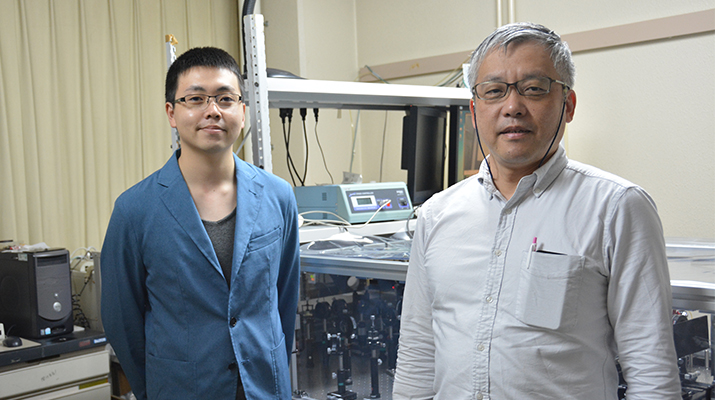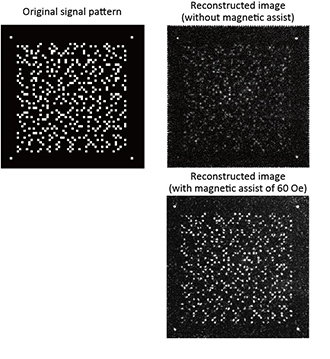
ここからコンテンツです。

First Step towards Practical Application of Holographic Memory with Magnetic Assistance
Error-free data recording and reconstruction with magnetic-holographic memory By Yuichi Nakamura
Yuichi Nakamura, Associate professor at Toyohashi University of Technology, and his group, are the first in the world to have successfully applied magnetically assisted recording to magnetic-holographic memory to reduce recording energy consumption and achieve error-free data reconstruction. This new technology may potentially allow for the practical application of magnetic-holographic memory as a rewritable, ultra-high-density and high-speed optical information storage medium.
In recent years the volume of information being distributed across the world has sharply risen due to new technologies such as high-speed with mass date transfer of the Internet and 8K broadcasting. In response to this trend, there is increasing demand for an innovative method for storing large volumes of data at ultra-high recording density and at ultra-high speed. Magnetic-holographic memory is one type of technology apparently capable of meeting this demand, since it can be used to record 1 TB worth of data (equivalent to the total capacity of 40 Blu-ray discs, each with a typical capacity of 25 GB) on a disc the size of a DVD or Blu-ray disc.
In magnetic hologram recording, a medium is magnetized in one direction; then the medium is irradiated with an information-bearing beam (signal beam) and a reference beam; and the resulting interference pattern is recorded in the form of the difference in magnetization directions. When this recording proceeds with an external magnetic field applied to it, the recording of the difference in magnetization directions becomes clearer. The latter process is called magnetically assisted recording.
The research group led by Yuichi Nakamura has applied this magnetically assisted recording technology to magnetic-holographic memory and, for the first time in the world, succeeded in reducing recording energy consumption and achieving error-free data reconstruction.

Through simulation, the group investigated the size of the stray magnetic field required for magnetization reversal in magnetic hologram recording. As a result, they found that the thinner the medium, the smaller the necessary stray magnetic field and the less clear the hologram recording. They also proved through experiments that magnetically assisted recording yields a clear magnetic hologram even with a thin medium, and the magnetic hologram yields a bright reconstruction beam upon irradiation with a reference beam. Through further experiments, they found that magnetically assisted recording and reconstruction of two-dimensional data yields clear reconstruction images. As a result of this research, the group have achieved a world first by managing a significant reduction in errors in data recording and reconstruction for low energy consumption as well as error-free recording and reconstruction with magnetic-holographic memory.
"Until now it has been difficult to obtain a clear reconstruction image with a magnetic hologram, due to strict requirements for material characteristics, optical conditions, and so on. Using magnetically assisted recording, we have relaxed these requirements and also improved the reconstruction performance of recording media. This technology is promising for the future application of magnetic-holographic memory," says first author Shirakashi.
The research group intends to proceed with their work to improve recording density, and their goal is to apply this technology to make a portable, ultra-high-density and high-speed optical information storage medium (outperforming Blu-ray discs) capable of storing high-volume contents from various sources including 8K Super Hi-Vision broadcasting and 3D films; and to enable wide application of this technology in various types of storage systems, including archive and cold storage for storing information such as medical image data, SNS data on the Internet, and high-volume data in data centers.
This work was supported in part by Grants-in-Aid for Scientific Research (S) 26220902 and (A) 15H02240.
Reference
Zen Shirakashi, Taichi Goto, Hiroyuki Takagi, Yuichi Nakamura, Pang Boey Lim, Hironaga Uchida & Mitsuteru Inoue, “Reconstruction of non-error magnetic hologram data by magnetic assist recording” Scientific Reports,7, Article number: 12835 (2017).
http://dx.doi.org/10.1038/s41598-017-12442-z
磁気アシストによるホログラムメモリ実用化への第一歩
磁気ホログラムメモリのエラーゼロでの記録・再生に成功By 中村 雄一
中村雄一准教授らのグループは、磁気アシスト記録によって、世界で初めて磁気ホログラムメモリの記録エネルギーの低エネルギー化とエラーゼロでの再生に成功しました。これは、書き換え可能な超高密度高速光情報ストレージとして、磁気ホログラムメモリの実用化に貢献する技術です。
近年、インターネットや8K放送をはじめ、世の中に流通する情報は増え続けており、そうした大容量データを超高記録密度・超高速で保管する革新的な技術が求められています。磁気ホログラムメモリはそうした要求を満たす技術の1つであり、DVDやBlu-ray Discと同じサイズのディスクに1TB(通常の容量25 GBのBlu-rayディスク40枚分)を超える情報を記録できる技術です。
磁気ホログラムは、記録の際、一方向に磁化させたメディアに情報を持った光(信号光)と参照光を照射すると両者が干渉して、その結果生じる光の強弱のパターンが磁化の向きの違いとして記録されます。このとき、外部から磁場をかけながら記録することで、磁化の向きの違いをはっきりと記録することが可能となり、これを磁気アシスト記録といいます。
中村雄一准教授らの研究グループは、この磁気アシスト記録という手法を用いて、世界で初めて磁気ホログラムメモリの記録エネルギーの低エネルギー化とエラーゼロでの再生に成功しました。
研究グループは、シミュレーションにより、磁気ホログラム記録時に磁化を反転させるのに必要な浮遊磁界の大きさを評価し、メディアの膜厚が薄いほど浮遊磁界が小さくホログラムの記録が不鮮明になる傾向があることを見いだしました。そして、メディアの膜厚が薄い場合であっても、磁気アシスト記録を行うことにより、はっきりとした磁気ホログラムが形成でき、形成できた磁気ホログラムへ参照光を照射することで、明るい再生光が得られることを実験で示しました。その後、二次元データを磁気アシスト記録し、再生したところ、明瞭な再生像が得られ、より小さなエネルギーで書き込んでも記録・再生したデータのエラー数を劇的に低減でき、エラーゼロでの記録・再生ができることを初めて実験で示しました。
第一著者の白樫は「これまで磁気ホログラムで明瞭な再生像を得るためには、材料特性や光学条件などが厳しく困難でしたが、今回、実証した磁気アシスト記録ではこれらの記録条件を緩和し、かつ記録媒体の再生特性を向上させることができるようになりました。今後の磁気ホログラムメモリの実用化に向けて、この手法が貢献できると期待しています。」と述べています。
今後は記録密度の向上に向けた研究を推し進め、最終的にはBlu-rayディスクを超える超高密度高速光情報ストレージとして、8Kのスーパーハイビジョンや3D映画などの大容量コンテンツを入れて持ち運べたり、医療生体画像データやインターネットにおけるSNS、データセンターなどの大容量データのアーカイブ・コールドストレージなどに広く利用できる技術として確立することを目指しています。
本研究の一部は科学研究費補助金 基盤(S) 26220902 および 基盤(A) 15H02240の補助を受けて実施しました。
Researcher Profile

| Name | Yuichi Nakamura |
|---|---|
| Affiliation | Department of Electrical and Electronic Information Engineering |
| Title | Associate Professor |
| Fields of Research | Thermoelectric materials and engineering / Spin caloritronics / Magnetic hologram memory / Electrical and electronic materials / Materials processing |
ここでコンテンツ終わりです。
